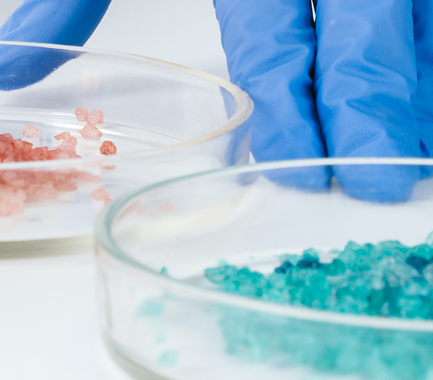Your contact
PENPET-Team - Hamburg

Jan Prager
Sales
Tel. +49 (0) 40 - 675 7 99 10
sales@penpet.de
Get in touch with us.
Isophorone
Isophorone is an organic compound that belongs to the cyclic enones and is an important solvent for various areas of industry. The substance is produced from the simple ketone acetone in a multi-step aldol condensation process. In each case, three molecules of the starting material combine to form one molecule of isophorone. Intermediates of this process are diacetone alcohol and mesityl oxide. Natural occurrences of the compound include fruits, nuts, and some grains, as well as foods like white wine and Parmesan cheese.
The substance is used as a solvent in the production and processing of paints, varnishes, coatings, oils, fats, resins, nitrocellulose, pesticides and adhesives. In addition, isophorone is used as a starting material for the synthesis of chemical compounds such as isophorone diisocyanate, isophorone diamine and 3,5-dimethylphenol and for the production of thermoplastic polycarbonates.
At PENPET you get isophorone of the highest quality, from a reliable partner who will also meet your requirements in the long term. We look forward to receiving your inquiry for an individual offer. Prompt delivery of the liquid compound can be made in packages with different weights.
CAS no. 78-59-1
EINECS no. 201-126-0
Molecular formula: C9H14O
Synonyms: α-Isophorone, 3,5,5-Trimethylcyclohex-2-enone, 3,5,5-Trimethyl-2-cyclohexen-1-one, 3,5,5-Trimethylcyclohex-2-en-1-one
Areas of application: Starting material for synthesis processes in organic chemistry, solvent for resins, fats, oils, paints, varnishes, coatings, pesticides, adhesives and nitrocellulose
More Information
As a cyclic enone with several attached methyl groups, isophorone has a complex structure. The molecules of the substance consist of a ring-shaped cyclohexene structure, the carbon atoms of which have bonds to three methyl radicals and one oxygen atom. The oxygen atom is attached via a double bond. It forms a carbonyl group with the corresponding carbon atom, due to which the compound belongs to the ketones and the enones. The double bond of the cyclohexene ring is in close proximity to this functional group, one carbon atom away. It gives isophorone its unsaturated character, which allows the compound to undergo addition reactions such as simple hydrogenation.
The second-nearest carbon atoms on either side of the ring structure, seen from the carbonyl group, are linked to the three methyl radicals of the substance, with the carbon atom located at the double bond having one methyl group and the carbon atom opposite the double bond having two methyl groups. For the exact naming of this structure, isophorone is also described as 3,5,5-trimethyl-2-cyclohexen-1-one. To distinguish it from an isomeric compound, this substance is also referred to as α-isophorone, while β-isophorone has a different position of the double bond.
Isophorone is in liquid form. The low-volatile compound solidifies when it cools below -8 °C and changes to the gaseous state at temperatures above 215 °C. The substance has a colorless to slightly yellowish appearance. It has a characteristic odor reminiscent of camphor and peppermint.
Isophorone can be dissolved very well in benzene, acetone, toluene, diethyl ether, hexane, ethanol, dichloromethane and many other aliphatic and aromatic hydrocarbons. In contrast, it is only poorly soluble in water. Undissolved amounts settle floating on the water due to the lower density of the substance.
If stored in an airtight, cool, dry and protected from light, isophorone can be stored stably for a long time. However, under the influence of light and in aqueous solution, isophorone tends to spontaneously dimerize. In contact with oxygen, the compound may form explosive peroxides.
Isophorone is a flammable substance, but in liquid form it is difficult to ignite. At temperatures above 84 °C, however, the vapors of the compound can form highly flammable and explosive mixtures with the ambient air. Due to their significantly higher density, the vapors can also spread unnoticed on the ground, which can lead to dangerous remote ignition of the compound. When handling open containers of the substance, it is therefore important to ensure a sufficient safety distance from potential sources of ignition such as sparks, open flames, heated surfaces and electrostatic discharges. Burning isophorone produces irritating and harmful gases such as carbon dioxide and carbon monoxide.
Isophorone is a hazardous substance that is harmful to health. While the compound only causes slight irritation and redness on the skin, it can cause burning pain in the eyes, increased tearing, eyelid spasms, and clouding and inflammation of the conjunctiva. After gentle rinsing under running water, the affected eye should be examined and treated by an ophthalmologist. Wetted parts of the body can be cleaned of residues of the compound with water and polyethylene glycol 400.
Inhalation of vapors or aerosols of the liquid is irritating to the respiratory tract and at higher concentrations can cause edema and inflammation of the lungs. If the substance is swallowed, irritation and burning pain in the mouth, throat and esophagus are to be expected. Gastrointestinal symptoms such as nausea and vomiting can also occur. The absorption of isophorone into the metabolism disrupts and paralyzes the central nervous system. The possible symptoms range from drowsiness and discomfort to headaches, dizziness, nausea and intoxication to unconsciousness, respiratory paralysis and coma. If isophorone poisoning is suspected, call medical assistance to the scene immediately.
Isophorone is considered to be slightly hazardous to water and should not get into water, soil or wastewater.
